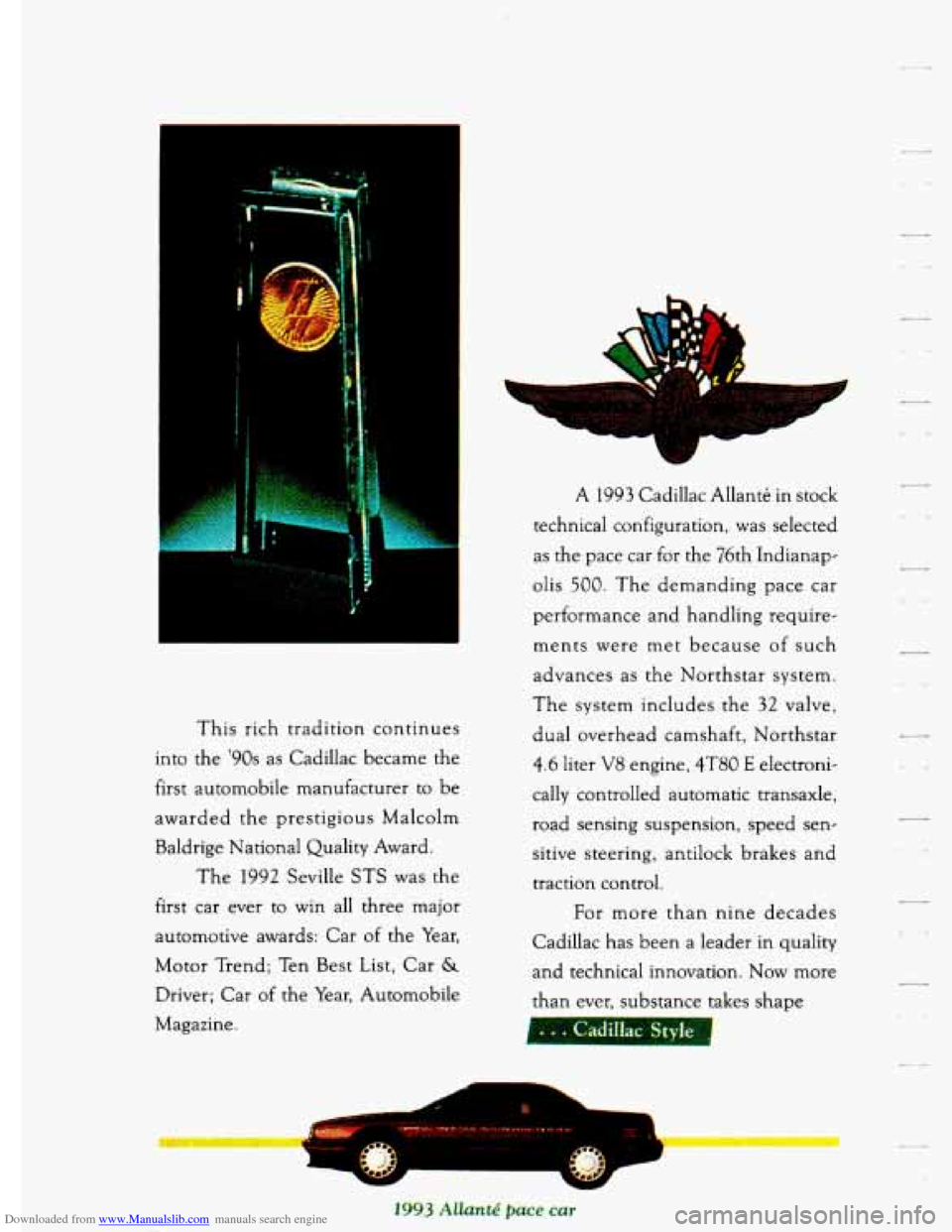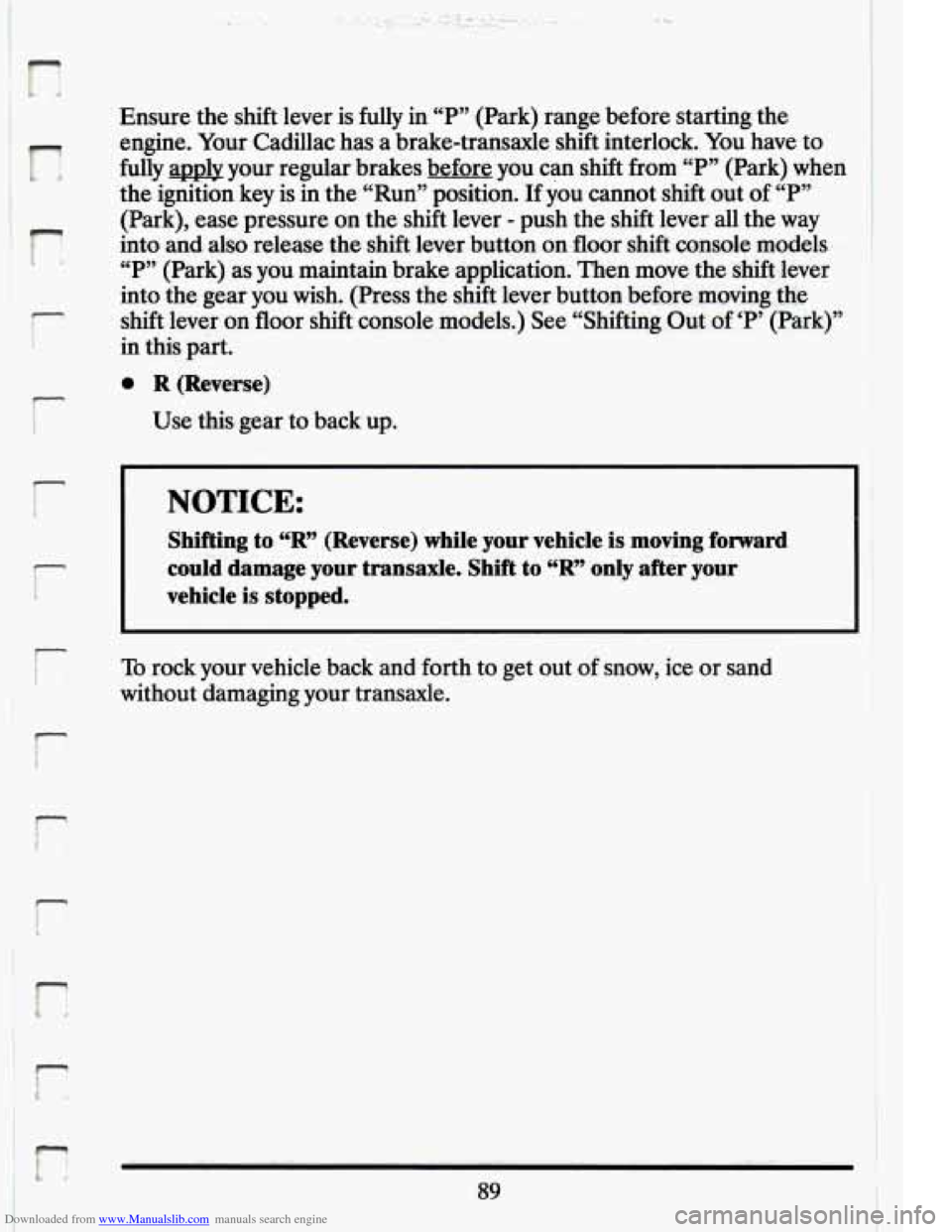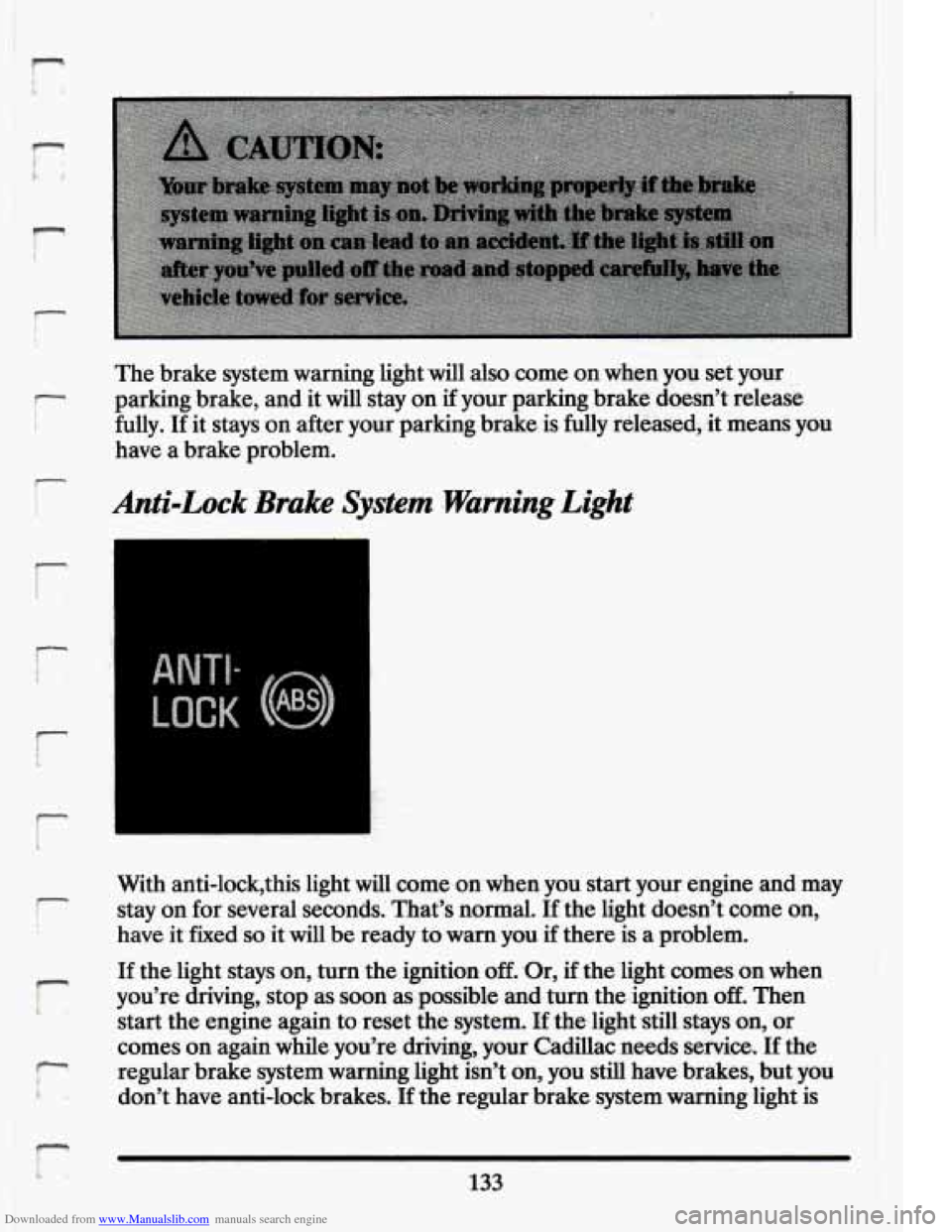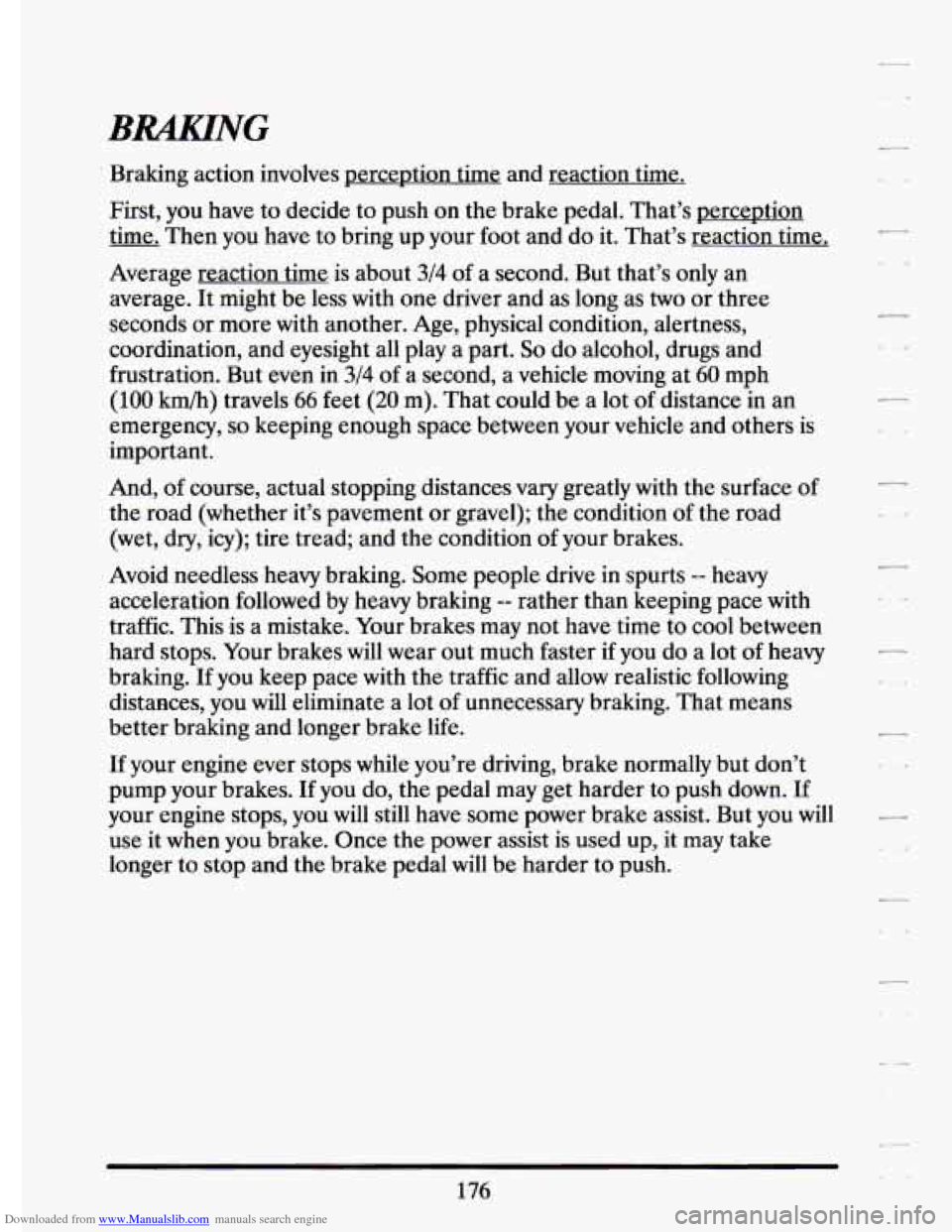Page 8 of 398

Downloaded from www.Manualslib.com manuals search engine This rich tradition continues
into
the '90s as Cadillac became the
first automobile manufacturer
to be
awarded the prestigious Malcolm
Baldrige National Quality Award.
The
1992 Seville STS was the
first car ever to win all three major
automotive awards: Car
of the Year,
Motor Trend; Ten Best List, Car &
Driver; Car of the Year, Automobile
Magazine.
A 1993 Cadillac Allantk in stock
technical configuration, was selected
as the pace car for the
76th Indianap-
olis
500. The demanding pace car
performance and handling require- ments were met because of such
advances as the Northstar system.
The system includes the
32 valve,
dual overhead camshaft, Northstar
4.6 liter V8 engine, 4T80 E electroni-
cally controlled automatic transaxle,
road sensing suspension, .speed sen-
sitive steering, antilock brakes and
traction control. For more than nine decades
Cadillac has been a leader in quality
and technical innovation. Now more
than ever. substance takes shape
L
Page 101 of 398

Downloaded from www.Manualslib.com manuals search engine r!
Ensure the shift lever is fully in “PYy (Park) range before starting the
engine. Your Cadillac has a brake-transaxle shift interlock. You have to
fully
apply your regular brakes before you can shift from “PYy (Park) when
the ignition key is in the “Run” position.
If you cannot shift out of “PYy
(Park), ease pressure on the shift lever - push the shift lever all the way
into and also release the shift lever button on floor shift console models
“Pyy (Park) as you maintain brake application. Then move the shift lever
into the gear you wish. (Press the shift lever button before moving the
shift lever on floor shift console models.) See “Shifting Out of ‘P’ (Park)”
i i in this part.
@ R (Reverse)
Use this gear to back up.
r L NOTICE:
Shifting to “R” (Reverse) while your vehicle is moving forward
could damage your transaxle. Shift to
“R” only after your
vehicle is stopped.
r
r To rock your vehicle back and forth to get out of snow, ice or sand
without damaging your transaxle.
89
Page 103 of 398

Downloaded from www.Manualslib.com manuals search engine tf
r
I.
NOTICE:
If your vehicle seems to start up rather slowly, or if it seems not
to shift gears
as you go faster, something may be wrong with a
transaxle system sensor. If you drive very far that way, your
vehicle can be damaged.
So, if this happens, have pour vehicle
serviced right
away Until then, you can use “2” (Second Gear)
when you are driving less than
35 mph (56 h/h) and @)
(Overdrive) for higher speeds.
F 1, 3 (Third Gear)
This is like
@, but you never go into Overdrive.
Here are some times you might choose
“3” instead of @:
- When driving on hilly, winding roads
- When towing a trailer, so there is less shifting.between gears
- When going down a steep hill
2 (Second Gear)
This position gives you more power but lower fuel economy. You can
use
“2” on hills. It can help control your speed as you go down steep
mountain roads, but then you would also want
to use your brakes off
and on.
r NOTICE:
Don’t drive in (‘2” (Second Gear) for more than 5 miles (8 km),
or at speeds overS5 mph (88 km/h), or you can damage your
transaxle.
Use “@)” or c63” as much as possible.
Don’t shift into
“2” u.nless you are going slower than 65 mph
(105 Wh), or you can damage your engine.
91
Page 104 of 398
Downloaded from www.Manualslib.com manuals search engine 1 (First Gear)
This position gives you even more power (but lower fuel economy)
than
“2.” You can use it on very steep hills, or in deep snow or mud. If
the selector lever is put in “1,” the transaxle won’t shift into first gear
until the vehicle is going slowly enough.
NOTICE:
If your front wheels can’t rotate, don’t try to drive. This might
happen if you were stuck in very deep sand
or mud or were up
against
a solid object. You could damage your transaxle.
Also, if you stop when going uphill, don’t hold your vehicle there
with only the accelerator pedal. This could overheat and
damage the transaxle. Use your brakes to hold your vehicle in
position
on a hill.
PmNG BRAKE
92
Page 145 of 398

Downloaded from www.Manualslib.com manuals search engine ..
‘The brake system warning light will also.come on when you set your
parking ,brake, and it will stay on if your.:parking brake doesn’t release
fully. If
it stays on after your parking .brake is fully released, it means you
have a brake problem.
Anti-Lock 3rake System warning Light
LOCK
With anti-lock’this light will come on when you start your engine and may
stay on for several seconds. That’s normal. If the light doesn’t come
on,
have it fixed so it will be ready to warn you if there is a problem.
I-
i
If the light stays on, turn the ignition off. .Or, if the ‘light. comes on when
you’re driving, stop as soon as possible and turn the ignition
off. Then
start the engine again
to reset the system. If the-light still. stays on, or
comes on again while you’re driving, your Cadillac needs service.
If the
regular brake system warning
1ig.M isn’t. on, you still have brakes, but you
don’t have anti-lock brakes.
If the regular brake system warning light is
133
Page 146 of 398
Downloaded from www.Manualslib.com manuals search engine also on, you don’t have anti-lock brakes and there’s a problem with your
regular brakes. See “Brake System Warning Light” earlier in this part.
Engine Temperature Warning Light
(Canadian \Export Only)
This light tells you that
your engine has
overheated. You
should stop the car and
idle the engine as soon
as possible.
A warning
chime should also
sound if this light
comes on.
As a check,
the light should come
on
for a few seconds
when
you start your
engine.
HOT COOLANT CAN BURN YOU BADLY!
In “Problems on the Road,” this manual shows what to do. See “Engine
Overheating” in the Index.
Malfunction Indicator Lamp
SERVICE
ENGINE
SOON
SERVICE
ENGINE SOON
134
Page 187 of 398
Downloaded from www.Manualslib.com manuals search engine P
You have three systems that make your vehicle go where youwant it to
go. They .are the brakes, the. steering and the accelerator. All three
systems haveto do. their work at the places where the tires meet the road.
~
,
,
~
Sometimes, as when you're driving on snow or ice, it's easy to-ask more of
those control systems thanthe tires and.road can provide. That. means
you can.lose control
of your vehide.. .
175
Page 188 of 398

Downloaded from www.Manualslib.com manuals search engine BRAKING
Braking action involves perception time and reaction time. First, you have to decide to push on the brake pedal. That’s perception
time. Then you have to bring up your foot and do it. That’s reaction time.
Average reaction time is about
3/4 of a second. But that’s only an
average. It might be less with
one driver and as long as two or three
seconds or more with another. Age, physical condition, alertness,
coordination, and eyesight all play a part.
So do alcohol, drugs and
frustration. But even in
3/4 of a second, a vehicle moving at 60 mph
(100 km/h) travels 66 feet (20 m). That could be a lot -of-distance in an
emergency,
so keeping enough space between your vehicle and others is
important.
And, of course, actual stopping distances vary greatly with the surface of
the road (whether it’s pavement or gravel); the condition of the road
(wet, dry, icy); tire tread; and the condition
of your brakes.
Avoid needless heavy braking. Some people drive in spurts
-- heavy
acceleration followed by heavy braking
-- rather than keeping pace with
traffic. This
is a mistake. Your brakes may not have time to cool between
hard stops. Your brakes will wear out much faster
if you do a lot of heavy
braking. If you keep pace with the traffic and allow realistic following
distances, you will eliminate a lot
of unnecessary braking. That means
better braking and longer brake
life.
If your engine ever stops while you’re driving, brake normally \
but don’t
pump your brakes. If you
do, the pedal may get harder to push down. If
your engine stops, you will still have some power brake assist. But you will -
use it when you brake. Once the power assist is used up, it may take
longer to stop and the brake pedal will be harder to push.
c-
176